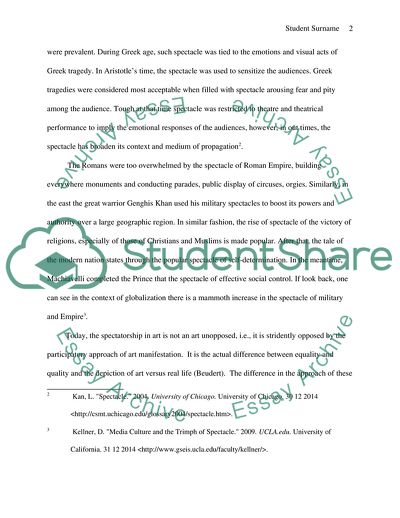Cite this document
(Concept of the Spectacle in Contemporary Art Report Example | Topics and Well Written Essays - 2500 words, n.d.)
Concept of the Spectacle in Contemporary Art Report Example | Topics and Well Written Essays - 2500 words. https://studentshare.org/history/1855026-how-has-the-concept-of-the-spectacle-been-applied-to-the-contemporary-display-of-art-do-you-think-this-critique-is-justified-in-your-answer-you-should-refer-in-detail-to-at-least-one-institution
Concept of the Spectacle in Contemporary Art Report Example | Topics and Well Written Essays - 2500 words. https://studentshare.org/history/1855026-how-has-the-concept-of-the-spectacle-been-applied-to-the-contemporary-display-of-art-do-you-think-this-critique-is-justified-in-your-answer-you-should-refer-in-detail-to-at-least-one-institution
(Concept of the Spectacle in Contemporary Art Report Example | Topics and Well Written Essays - 2500 Words)
Concept of the Spectacle in Contemporary Art Report Example | Topics and Well Written Essays - 2500 Words. https://studentshare.org/history/1855026-how-has-the-concept-of-the-spectacle-been-applied-to-the-contemporary-display-of-art-do-you-think-this-critique-is-justified-in-your-answer-you-should-refer-in-detail-to-at-least-one-institution.
Concept of the Spectacle in Contemporary Art Report Example | Topics and Well Written Essays - 2500 Words. https://studentshare.org/history/1855026-how-has-the-concept-of-the-spectacle-been-applied-to-the-contemporary-display-of-art-do-you-think-this-critique-is-justified-in-your-answer-you-should-refer-in-detail-to-at-least-one-institution.
“Concept of the Spectacle in Contemporary Art Report Example | Topics and Well Written Essays - 2500 Words”. https://studentshare.org/history/1855026-how-has-the-concept-of-the-spectacle-been-applied-to-the-contemporary-display-of-art-do-you-think-this-critique-is-justified-in-your-answer-you-should-refer-in-detail-to-at-least-one-institution.


